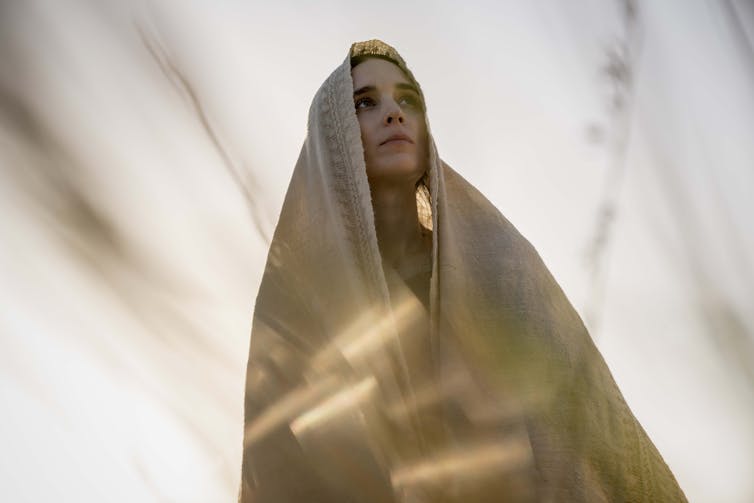Easter is the season when Christians remember the death and resurrection of Jesus Christ. It’s also a season when Hollywood turns its attention to releasing biblically-themed films. This year is no exception.
Mary Magdalene has been roundly praised for its focus on one of Jesus’ most overlooked followers. But the film, and its release just prior to the Easter season, is problematic for its subtly negative depiction of Jewishness.

Historically, the Easter season has been a very dangerous time for Jews, who have frequently been wrongly blamed for Jesus’s death. Early Christian Easter homilies from antiquity were taken by some as opportunities to harness the rhetoric of Christian anguish about the death of Christ into an antisemitic mob.
Mary Magdalene dodges many of the anti-Jewish pitfalls of earlier Jesus films by avoiding the trial scenes before Pilate (where films sometimes include a furious Jewish mob lobbying an “innocent” Pilate for Jesus’s death) and Herod (a Jewish ruler whom Luke includes as partially responsible for Christ’s crucifixion).
But it stigmatises Jews in less obvious ways that are nevertheless dangerous. The respect I have for two of the film’s consultants, professors Joan Taylor and Amy Jill Levine, leads me to believe that these subtler anti-Jewish features of the film must have been inadvertently included without their knowledge.
The subtlety of the film’s anti-Judaism is best illustrated in one of the opening scenes of the film, in which Mary and her family visit a synagogue to worship. In praise of the filmmakers, I should point out that the synagogue of Magdala is one of the oldest dedicated synagogue buildings excavated in Galilee and likely was in use in the early first century CE. However, once the characters enter the synagogue and begin to pray, several problems become apparent. First, we have no evidence to support a division of genders in synagogue worship in antiquity, despite what the film shows.
And while most of the film takes place in English (of varying accent and dialect) the prayers in the first synagogue scene are in Hebrew (rather than Aramaic, the common language of the time). The prayers also follow a pattern similar to ones used among Mizrahi Jewish communities today.
These two anachronistic elements, the gender segregation and the modern Hebrew liturgy, present a problematic image of Judaism. In the first instance, gender segregation is presented as an aspect of Judaism that an innovative Jesus is depicted as resisting in his inclusion of first Mary and then other women in his ministry. This sets up the image of a “Radical Jesus” who revolutionises a “backwards” and “antiquated” Judaism and is killed as a result.
Depicting Jews from first century Galilee as praying in the same voice as Jews from the 21st century is equally troubling. This makes it seem like the content and manner of worship is the same today as it was 2,000 years ago. This choice means that the film (perhaps inadvertently) participates in the supersessionist notion prominent in some Christian circles that Judaism hasn’t changed since Jesus’s time.
Anachronistic
On the one hand, I applaud the filmmakers for choosing a dialect indigenous to the geographical location of the film. Acknowledging the diversity of Judaism is important, both in antiquity and today. On the other hand, using contemporary liturgy and contemporary language from any community is problematic: it presents Judaism as unchanging from antiquity to today. The idea that contemporary Jewish practice is the key to understanding the Judaism of Jesus is a pervasive and deeply supersessionist (the idea that Christianity replaces and improves on Judaism) assumption.
[tweet id=”976933551030534146″]
This short scene might not look like much in the context of a film that runs for more than two hours. But it underpins the characterisation of Jesus as radically opposed to the Judaism of his day. This is a troubling depiction of Jesus (played in the film by by Joaquin Phoenix), and can be seen in the character’s obsessive focus on “faith”: the film seems to situate faith in God as opposed to Jewish ritual concerns.
The real Jesus
The Jesus of the Gospels, in contrast to Phoenix’s portrayal, is urgently concerned with upholding and reinforcing Jewish law. The valuing of faith over works reflected in the film represents a post-Reformation misunderstanding of the Pauline discussion (which is really a debate about whether Gentile followers of Jesus need to adhere to Jewish kosher laws and circumcision). The false dichotomy of faith over and against works is in any case countered by other texts in the New Testament.
[tweet id=”977148707052408833″]
The film’s Jesus is so focused on his opposition to Jewish ritual practice in general that the famous Temple scene where Jesus overturns the stalls of the money-changers is reimagined. In the film, Jesus rejects the sacrifices that take place in the Temple rather than the specific marketisation of worship. This reinforces the supersessionist idea that Jesus opposed “archaic” Judaism in favour of Protestant “faith”. Phoenix’s Jesus does quote Isaiah, following the Gospels; in that sense the film is true to the biblical account. But he also questions the entire practice of sacrifice, asking: “Does God demand that this is how the people should show their true repentance? A flick of your knife on the altar. … Have their hearts been altered when they leave this place?”
Not only does this rejection of temple sacrifice not reflect the Gospel accounts, but it also poses problems for the sacrificial interpretations of Jesus’s own death found in the New Testament.
In the end, while the film avoids much of the explicit antisemitism previous interpretations of Jesus have included, from antiquity to the 21st century, we are left with a film that is arguably supersessionist. Intentionally or not, it helps to prop up a view of Judaism as archaic, unchanging and out of date, placing contemporary language and prayer in characters from 2,000 years ago. It also props up a view of Judaism as a system opposed to the dominant valued idea of what it means to be “truly” religious or spiritual today: faith as opposed to “empty” ritual.
It supports the idea of Jesus being a radical innovator of a curiously post-Reformation Protestant theology, which, after Martin Luther, prioritised faith over ritual acts. These aspects of the film will no doubt be popular with evangelical communities, but at the same time they could arguably send a dangerous message in the context of increasing numbers of antisemitic attacks often carried out by those who understand Christianity to support white supremacy.


























